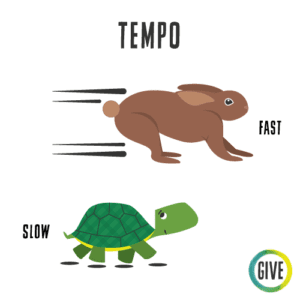Gripe into Glow Orchestra
Contribution de Laura Borgwardt
![]()
![]()
![]()
Description
This music and movement activity invites students to use volume, sound, and reflection to represent their feelings. The activity can be an energy or mood changer that brings healing practice into the classroom.
instructions
- Lead the group in finding a basic rhythm (e.g., stomp clap, stomp stomp clap).
- Have the students make the same rhythm, but quietly. Practice conducting the volume: hands up for loud, and down for soft.
- Invite the group to continue the beat quietly while you explain the instructions:
- “Think of one thing that makes you mad or irritated. This will be your ‘gripe.’”
- “We’re going to add on to this beat, one person at a time, to make a sound, movement, or rhythmic spoken phrase to express your gripe. This is something you will repeat over and over again.”
- Once everyone has added to the orchestra, conduct the volume, and consider changing tempos.
- Invite the group to continue their gripes quietly while you explain the next part:
- “Think of one thing that makes you happy, something you are proud of, or you are excited about. This will be your ‘glow.’”
- “We’re going to change, one person at a time, from our gripe sound/phrase to make a sound, movement, or rhythmic phrase to express your glow. This is something you will repeat over and over again.”
- Once everyone has changed to a glow orchestra, conduct the volume, and maybe change tempos, leading to a grand finale or fade-out.
- Réflexion:
- “How did it feel to express your complaints out loud?”
- “How did it feel to transition from an orchestra of gripes to an orchestra of glows?”
- “What might it have been like if we started with glows and ended with gripes?”
Transition vers l'activité
Form a circle and then start the beat, or start a beat and encourage everyone nonverbally to make the beat with you as they get into a circle.
Transition hors de l'activité
Lead the group in taking two collective breaths, in and out.
Aménagement de la salle de classe
This ideally takes place in a circle in an open area.
Supports/Matériaux adaptatifs/Outils
- Chart an options bank by brainstorming gripes. You might change the language to “complaints,” “grows,” “thorns,” etc. to match vocabulary they are already familiar with.
- Have a “do now” when entering the room: “Write a gripe on one color sticky note and a glow on a different color sticky note. Keep your sticky notes with you as we meet in a circle.” Students can then refer to their previously written content when creating a musical sound or phrase.
- “Create different movements to express your gripe and glow instead of a sound.”
- “Choose two different instruments and two sounds—one harsh and one soft—to play in the orchestra to represent your gripe and glow.”
- When you are conducting, give students cues to keep going or repeat. As the conductor, you could have part of the group get quieter, invite a solo or small-group moment, etc.
- Connect to previously learned musical terms. Have vocabulaire visuel posted for terms you are referencing. Point to or show a visual and say the name of a dynamic instead of a hand cue. Some helpful examples for this activity could include dynamique et tempo.
- You can use visual representations of feelings for students to gesture to if they are not verbal. Students could also draw their gripes and glows if that’s available to them.
Rôles possibles pour les professionnels de la classe
- Model full participation: Have them stand next to you to be the first to add a sound/phrase.
- Chart options as they’re shared.
- Side coach. If someone gets stuck, provide an intraverbal: “It makes me mad when ___. What sound or word can you use to express that?”
Réglages pour l'instruction à distance
![]()
- You might create a soft recorded beat to play in the background using audio-only share, so that there is no interference when students unmute to share.
- You can scaffold creating a beat and then adding words or other sounds to that beat. Students can then create an individual beat and add words, sounds, or gestures to this beat so that there is no interference with too many people sharing unmuted at one time and canceling out one another’s sound.


